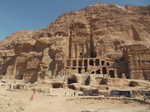Home » Adventures » Holy Land » Petra
I visited the ancient ruins in Petra, Jordan, a city carved magnificently into the rock walls of canyons. The day tour from Israel was ridiculously expensive, so I opted for the independent route. As I learned firsthand though, with every single person extracting as much money from tourists as possible, the pricey day tour was about the same cost as an independent, solo traveler.
My first hassle was getting into Jordan. I did not do my homework and showed up several hours before the border crossing opened, since it opened late on a weekend. I then was held up paying my Israel “exit tax,” with all the tour groups that prepaid this fee jumping ahead of me to the immigration lines. I had to stand in several long, slow moving queues for a couple stamps on my passport. I did not hit Jordanian soil until midmorning. I had no hope of catching the cheap bus from Aqaba (I really should have crossed the border the night before, but did not realize that until I was already settled at my hostel in Israel), so I had to take an expensive cab with an annoying driver to Petra.
After a lot of hassle I finally arrived at Petra and paid the exorbitant admission price. At least once I entered, the wonderful city made me forget the unpleasantness in getting there, as I marveled at its wonders. On the way in through a wide valley there were already occasional large rock monuments carved into the sides. These had the appearances of large buildings, but were in fact elaborate facades carved into the rock face. They were not lived in either, but used as tombs. The insides were usually a bare, square room with several pits for graves.
The valley then narrowed into a tall, windy chasm — The Siq. This route was the same one used during the city’s peak in the first and second century. The smooth, high walls of the Siq were impressive on their own, but monuments, shrines, and artwork were carved into the rock faces as well. The most impressive artwork still visible was a larger than life camel train. Inside the chasm an elaborate channeling system to carry water into the city had been built. Parts of the piping were still clearly visible.
The Siq dead ended into another canyon at the Treasury, an impressive gigantic and detailed building carved into the rock walls. The masterpiece was again just a facade for a tomb though. Despite the outsides, insides were bare.
As I continued through the canyons, massive and magnificent tombs of similar scale continued along both sides. Some were very deteriorated while other still retained minute details. The Street of Facades was most impressive, and I admired the great carvings that dwarfed me.
Petra was more than just tombs, being a thriving city in its heyday, and a stadium that could hold several thousand people was carved directly into the cliff side. Several preexisting tombs were even destroyed for its construction.
Petra was understandably a very popular tourist destination, busy with people and tours wandering around. It was at least big enough to never feel crowded though.
I continued through the overwhelming ruins towards the Monastery, which got its name from being used as a church in a time after Petra was abandoned. I climbed up the path towards the Monastery, while constantly declining kids who wanted me to ride their donkey or the endless small shops touting their little trinkets. Even though hundreds of people passed by every day, they seemed personally offended when I was not interested. Although they were just trying to scrape by a living, they still got annoying after a while.

At the top of the path was the Monastery (and of course more shops), the larges rock carving in Petra. Although sandstone is relatively soft for rock, that such elaborate monuments were carved into the cliff faces using hand tools was still amazing. As elaborately as the facades were, invariably the insides were barren and undecorated, with a few pits for tombs. Near the Monastery were also a couple high points that overlooked the countryside and gave nice views.
On my way back from the Monastery I diverted up the High Place of Sacrifice trail. I had this way mostly to myself, as tour groups do not usually venture there and it was later in the afternoon already. Some of the most impressive ruins I saw all day were along here too. At the top was the altar, where incense was burned and animals sacrificed. Small channels were carved into the rock altar, which experts theorize could have been used to channel away the animals’ blood. From the top I also had a commanding view of the valleys, although the stone carvings were not visible.
I made my way out of Petra, still gazing at the numerous facades carved into the walls. Unfortunately I did not have a chance to return to Petra the next morning to watch the sunrise, as the only semi-reasonably priced ride back to Israel I could find left early in the morning. At least I had the pleasure of having my backpack thoroughly searched as I crossed back into Israel.
Even though going on my own to Petra involved a lot of hassle and cost the same as a tour bus, I am still glad I took an independent trip. I have never been on a bus tour I have thoroughly enjoyed, always feeling like cattle being rushed through a couple popular spots. I still visited many of the same sites on my own though, but could wander around at a more leisurely pace. I also found a few out of the way corners as well.
Petra was a neat place to visit and I enjoyed my time there — as long as I do not tally up how much it actually cost me.